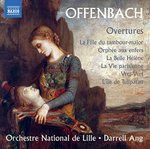|
Back
12/24/2017
“Overtures”
Jacques Offenbach: Overtures from: “Orphée aux enfers” (arr. C. Binder and J.G. Busch for Orchestra) – “La Fille du tambour-major” – “L’Ile de Tulipatan” – “Monsieur et Madame Denis” – “La Belle Hélène” – “Vert-Vert ‘Kakadu’” (arr. F. Hoffman) – “La Vie parisienne” – “La Grande-Duchesse de Gérolstein” – Ouverture à grand orchestre
Orchestre national de Lille, Darrell Ang (conductor)
Recording: Le Nouveau Siècle, Lille, France (March 22-25, 2016) – 65’45
Naxos 8.573694 – Booklet in English and French

   
What’s not to like about Jacques Offenbach? With an active, energetic mind, this German-born-turned-Parisian offered delight on many levels that sparked a smile (or two) to those living back in the 19th century as well as audiences in the now. And whilst a sort of formulaic equation settled into his musical cerebrum, they’re vast opportunities for elicitations through the conductor himself. Having personally witnessed the technique of
Darrell Ang in Orange County in March, one can see a generalized sense of balance and shifts in pacing predicated upon the composition at hand.
It’s interesting to eye selections culled from the Offenbachian repertoire. We span the Parisian’s life, from beginning to end, in the first two tracks, in a sort of musical “Cliffs Note” forward. An expectant Orphée aux enfers renders substantive tempos, though sections are overwrought with too much nervousness while La Fille du tambour-major, Offenbach’s mockery of La Fille du Régiment, doesn’t cleanly explicate the driving drum dimension. [Contrastingly, percussion is occasionally over magnified.]
The beauty therein lies within some of the more esoteric compositions, one being Monsieur et Madame Denis. Structurally, this parallels that of La Fille du tambour-major, and aside from tinny sounds in the opening bars, the remaining parlance speaks in Offenbach effervescence, especially the chaconne’s flute entrée. Dialogue between woodwinds and strings generate a lively chatterbox found inside L’Île de Tulipatan. Spritely ebullient, the oboe politely introduces the middle section. National Orchestra of Lille’s strides are catchy.
Plucky pizzicato ushering in Vert-Vert bobs away like a flighty bird with an almost Daniel-François Auber cadence. Strings are exceedingly poised and polished in their rendition of this 1869 œuvre; percussion pulsates like a Swiss watch. Frequently M. Ang enjoys markedly upping the tempo to dizzying heights to ignite the closing measures like a barrage of razor-like fireworks.
Most noteworthy, however, would be the closing and rarely heard Ouverture à grand orchestra since it presages an Offenbach of the future and his devotion to the theatre. [This would have been a more assiduous choice to entrée this CD.] Weighty passages bite sternly in an attempt to skip into the serious clauses from Les Contes d’Hoffmann. With a man characterized by musical whim and wit, it’s fascinating how a panoply of dramatic worth could tip this piece into a Beethovenian register; however, in the last minute and a half Jacques Offenbach teases us with a quasi coup d’théâtre, striking at his bouffe-to-come. Splendid.
Christie Grimstad
|